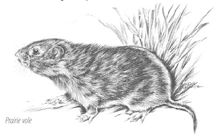Reward Mechanism Involved In Addiction Likely Regulates Pair Bonds Between Monogamous Animals

ATLANTA -- The reward mechanism involved in addiction appears to regulate lifelong social or pair bonds between monogamous mating animals, according to a Center for Behavioral Neuroscience (CBN) study of prairie voles published in the January 19 edition of the Journal of Comparative Neurology. The finding could have implications for understanding the basis of romantic love and disorders of the ability to form social attachments, such as autism and schizophrenia.In their research, funded by the National Institute of Mental Health, Larry Young, PhD., associate professor of psychiatry and behavioral sciences at Emory University School of Medicine and an affiliate scientist at Yerkes National Primate Research Center; graduate student Miranda Lim; and Anne Murphy, PhD., associate professor of biology at Georgia State University, examined the distribution of two brain receptors in the ventral forebrain of monogamous prairie voles that have been previously tied to pair bond formation: oxytocin (OTR) and vasopressin V1a receptor (V1aR). Using receptor audiographic techniques, the scientists found that these receptors are confined to two of the brain's reward centers, the nucleus accumbens and the ventral pallidum. V1aR receptors, which are thought to be activated in the male vole brain during pair bond formation, were confined largely to the ventral pallidum. OTR receptors, which play a crucial role in pair bond formation in females, were found mainly in the nucleus accumbens.
The V1aR and OTR receptors did not overlap between the two brain regions, and were equally distributed in the brains of male and female voles. According to Dr. Young, the findings, coupled with the close proximity of the nucleus accumbens and ventral pallidum-- two regions with heavily interconnected structures--suggest that a common neural circuit in male and female voles regulates pair bond formation.
Past studies have found the dopamine system of the nucleus accumbens produces the rewarding and sometimes addictive effects of sex, food and drugs of abuse. Dr. Young believes the same reward pathways are likely stimulated during and following pair bond formation.
"Although the process of pair bond formation results from the activity of two different neurochemicals in separate regions of the ventral forebrain in male and female vole brains," said Young, "the OTR and V1aR systems appear to activate two separate nodes of the same reward pathway to form and reinforce pair bonds."
In another finding, the CBN researchers determined that OTR and V1aR are closely located near the nerve fibers that release oxytocin and vasopressin. Lim speculated that their proximity likely facilitates pair bond formation during mating.
CBN studies currently underway continue to examine other components of the neural circuit involved in pair bond formation.
The monogamous prairie vole, which forms lifelong pair bonds, provides an ideal animal model for studying the neural basis of social attachment. In previous studies, CBN scientists have determined:
- The genes for vasopressin and oxytocin are critical for the proper processing of social information;
- A lack of genes for vasopressin and oxytocin receptors results in a deficit in social recognition and altered anxiety in mice;
- Vasopressin and oxytocin play key roles in the formation of social attachments between animals. Increasing the amount of vasopressin receptors in the brain using gene transfer techniques can increase pair-bonding behavior in monogamous male prairie voles.
* * *
